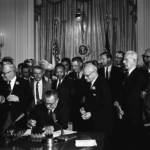These cases are about whether states are required to license same-sex marriages or to recognize lawful same-sex marriages performed in other states. In 2013, the Supreme Court ruled that one part of the federal Defense of Marriage Act was unconstitutional under the Fifth Amendment and the federal government had to treat same-sex married couples the same as all other married couples. Does the Fourteenth Amendment require states to do the same? Moreover, does the Fourteenth Amendment require that all states permit marriages between two people of the same sex?
Title IX
Title IX of the Education Amendments Act of 1972 prohibited discrimination on the basis of sex in educational settings. The law applied to any educational institution that received federal funding. This lesson has students learn about what Title IX does and explore its impact on gender equality today.
The Me Too Movement: Resources for PreK-12 Teachers and School Staff

The #MeToo and #MeTooK12 movement is an opportunity for schools to reflect on how to address issues of consent, sex education, relationships and undoing a pervasive culture of silence. April is also Sexual Assault Awareness month. The Share My Lesson team curated a collection of free resources to help educators with critical conversations and lesson planning, as well as school procedures and policies and opportunities for reflection.
The Equal Rights Amendment (ERA)
The Equal Rights Amendment (ERA) stated, “Equality of Rights under the law shall not be denied or abridged by the United States or any state on account of sex.” This proposed amendment was passed by Congress in 1972 but failed to be ratified by three-fourths of the states. This lesson provides an overview of the proposed amendment, arguments for and against ratification and possible future steps toward ratification. This lesson can be used in a traditional or flipped classroom.
The 14th Amendment and the Evolution of Title IX
Congress and the courts have applied the 14th Amendment’s equal protection clause to many aspects of public life over the past 150 years. In this activity, students will explore the evolution of the 14th Amendment through the lens of Title IX, which prohibits institutions that receive federal funding from excluding students from participating in educational and athletic programs on the basis of sex. The Supreme Court’s first Title IX case, Grove City College v. Bell, also demonstrates how each of the three branches exercises its authority.
The Amendment Process: Ratifying the 19th Amendment
In this activity, students will analyze historical records of Congress and the U.S. government to understand the sequence of steps in the amendment process. Students will study each document and match it to the step in the process that it illustrates.
When put in proper sequence, the documents will show the process by which the 19th Amendment – prohibiting the federal government or states from denying the right to vote on the basis of sex – was added to the Constitution.
Then students will reflect on the process, and the roles that the people, president, Congress and the states play.
The 1964 Civil Rights Act: Lesson Plans and Resources

On July 2, 1964, President Lyndon B. Johnson signed the Civil Rights Act into law. Originally proposed by President Kennedy in 1963, this landmark piece of legislation made discrimination based on race, religion, sex or national origin illegal. Additionally, the Civil Rights Act ended the practice of unequal voter requirements based on race or sex and ended racial segregation in schools. The Share My Lesson team has curated a collection of free lesson plans, activities, and classroom materials for educators to use in teaching students about the Civil Rights Act.
Constitutional Index – Amendment 19 Suffrage-Sex Clause
The Constitutional Index breaks down the U.S. Constitution by Section, Amendment, and Clause and contains broader topics and themes. These are used to cross-reference Library resources in an effort to annotate constitutional history.
Teaching LGBT Rights

The history of equal rights for members of the LGBT community is something often overlooked in classroom curriculum. With the Supreme Court ruling that same-sex marriage is a constitutional right, it is important to look back at the men and women who fought for equality, especially right here in Philadelphia. Events, such as Reminder Day, are examples of how we can remember the contribution of men and women in the community who fought for their rights as citizens.
Hollingsworth v. Perry (2013)
Does the 14th Amendment’s Equal Protection Clause prohibit California from defining marriage as the union of one man and one woman? This case summary shows how the Supreme Court answered that question in 2013.